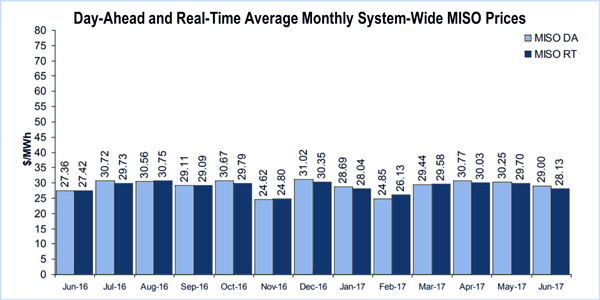By Amanda Durish Cook
MISO’s system operated as intended in June, which saw the usual early summer increase in loads, lower-than-expected natural gas prices and near-normal temperatures.
The RTO on June 13 hit a 111-GW peak for the month, 1 GW under the June 2016 peak, MISO Vice President of System Operations Todd Ramey reported during a July 25 Informational Forum. Average load was about 80 GW, up 10 GW compared with May and an expected outcome of the transition into summer, he said.
The increase in load was offset by the return of about 21 GW of generation from spring maintenance outages.
Prices averaged $29/MWh in the day-ahead market and $28.13/MWh in real time, lower than in May, where average prices for both hovered around $30/MWh. The small reduction resulted from natural gas prices averages staying below $3/MMBtu, a 7% decline from the prior month, Ramey said.
Two events caused real-time prices to deviate sharply above the day-ahead during the month, including a forced transmission outage in Louisiana on June 19 and a June 23 “contingency-related” event affecting the entire system.
While conditions in June were largely in line with norms, the MISO footprint experienced stresses from a mid-July heatwave that likely affected price and load, which will be reflected in the RTO’s July operations report, due out later this month.
“We just came off a week where parts of the footprint experienced some pretty extreme conditions,” CEO John Bear said.
Bear commended MISO control room staff and generation operators for successfully managing the high summer heat. He attributed smooth operations to the training and skill of operators.
Indianapolis Power and Light’s Lin Franks asked if MISO is considering turning to a dual-peak model using separate winter and summer dual peaks. The RTO currently models its peak using only summertime conditions.
“We have seen a narrowing of the gap between the summer peak and the winter peak,” Ramey said. “We observed that a couple of years ago in the polar vortex” and continue to see it, he said, adding that MISO staff may consider modeling the separate peaks.





